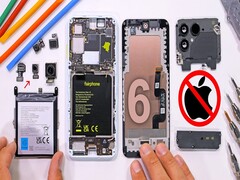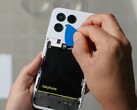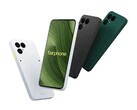Modular design with compromises
The Fairphone 6 continues the brand’s focus on repairability, though with slightly more complexity than the Fairphone 5. Unlike its predecessor, which featured a tool-free battery swap, the new model requires a Torx T5 screwdriver to remove the user-replaceable 4,315mAh battery, held by five screws. The back panel includes modular attachment points and accessories, such as a card holder or finger loop module, all packaged with braille for improved accessibility. The phone is rated IP55 for water resistance thanks to a rubber-sealed USB-C 2.0 charging port capable of 30W charging.
Its 6.3-inch LTPO OLED display offers 1 billion colors, a peak brightness of 1400 nits, and a 120Hz variable refresh rate. The screen and other components, including a 40 euros battery, a 90 euros screen, and a 25 euros lower speaker assembly, are already available for order in Europe but not yet in the US. Even with modular parts, the phone still uses a dated USB-C 2.0 interface, limiting data transfer speeds compared to modern Android flagships with USB 3.2.
Camera hardware and sustainability focus
The rear camera system consists of a 50MP primary sensor with optical image stabilization, a 13MP ultrawide camera without stabilization, and a 3D time-of-flight depth sensor. The 32MP front-facing camera is modular but lacks stabilization. Inside, the Fairphone 6 uses recycled tin and copper and minerals sourced from verified conflict-free suppliers. An etched map of the Democratic Republic of the Congo on the motherboard serves as a nod to the company’s focus on responsible material sourcing.
Another distinctive feature is the yellow “Fairphone Moment” slider on the side of the phone. When activated, this physical switch instantly disables most smartphone functions, effectively turning the Fairphone 6 into a basic device for calls and texts. This feature is designed for those who want to limit distractions or temporarily step away from smartphone use without needing to power off the device entirely.
The device retains Gorilla Glass 7i for screen durability, scratching at level six with deeper grooves at level seven, and shows mild frame flex in JerryRigEverything’s bend test despite its aluminum mid-frame.
US availability and pricing concerns
Although the Fairphone 6’s modularity and long-term support make it attractive for repair-focused buyers, US customers face significant drawbacks. The phone must be purchased through Murena for 900 dollars, roughly 200 dollars more than in Europe, with spare parts not yet available domestically. Replacement component pricing is also expected to be higher once stocked, reducing some of the cost-saving appeal that defines the Fairphone brand overseas.
Conclusion
The Fairphone 6 remains a compelling choice for those prioritizing sustainability, repairability, and long-term support, with modular components and a five-year warranty. However, in the United States, its inflated 900 dollar price and delayed spare parts undermine its value compared to the 599 euro European model, leaving American buyers with a mid-range phone at a near-flagship cost. While Europe gets a strong contender in the modular smartphone market, the US version currently feels like a compromise rather than a bargain.
















